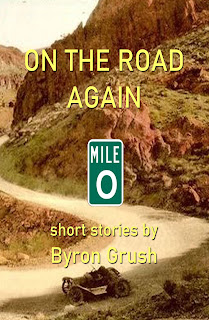buy the book
| Once Upon a Gold Rush |
| 5.0 out of 5 stars A great tale about some fascinating people By William A. Mego This is an extremely well-researched and insightful look at a period that could be best described as a passing madness, as men and women sought easy fortunes in the soils of California. And Grush serves it to us with all the flavor and detail we've come to expect. I am a fool for boats, so I treasured being able to enjoy a trip around the horn without having to experience the panic and frozen limbs those journeys usually required. Another welcome story about a remarkable family. |
| 5.0 out of 5 stars Another Intriguing Story By Nancy M. Mego "Once Upon a Gold Rush" continues the story of the Grosh family, following three of them as they travel with a wagon train from Illinois to California in 1850. The story is rich with detail of pioneer life as was the preceding book, " All the Way by Water." Starting from fragments of actual family history, "Once Upon a Gold Rush" is filled with real people, places, and historical events the Groshs might have encountered along the way. Not finding the hoped-for gold in California, one of the brothers returns to their Illinois home by sailing around the Horn of South America. His sea journey is filled with perils and more intriguing people and places. "Once Upon a Gold Rush" is a fun story for the whole family, a story of another family's exciting adventures. It is a skillful mix of family history and possibilities, interwoven with real places and real history. A delightful read and your kids might accidentlly learn some interesting history. |
| “Once Upon a Gold Rush” – A Review By Alex Schay, Portland, Oregon,August 9th, 2014 In his 2012 odyssey, “All the Way By Water”, Byron Grush relates the true story of how his ancestors made their way during the late 1840’s from Pennsylvania farm country to the relative wilderness of rural Illinois. In his 2013 sequel, “Once Upon a Gold Rush”, Mr. Grush takes his readers on a fantastic adventure, where his ancestors, John & James Grush, make their way by wagon from rural Illinois to California Gold Country, confront difficult choices at every turn, and eventually search for meaning in life. While this is a work of fiction, Once Upon a Gold Rush is grounded in reality, resulting in a truly compelling narrative.Careful research and quality story telling make this tale a worthwhile read; no detail is overlooked or left to chance. For example, at the start of the saga, the members of the Pine Creek Company must decide whether to employ oxen or mules to pull food & equipment. They must also choose between larger Conestoga Prairie Schooners and smaller Studebaker wagons. Finally, they must carefully select what to bring, what to leave behind, as well as when & where to stock up on provisions. To render the telling more realistic, Mr. Grush provides prices for corn, flour, bacon, coffee, and other essentials; he even goes so far as to note how the price of feed corn could change dramatically from one part of Frontier Iowa to another. At an important provisioning stop in Council Bluffs, the boys visit a daguerreotypist’s shop, where their images are memorialized forever and returned to their father in Illinois. Upon entering the daguerreotypist’s shop, Mr. Grush notes that the establishment, “had an acrid smell – a combination of burnt almonds & cow urine.” How does the author know this? Surely this knowledge comes from countless hours spent studying original source material both in California and at The Wisconsin Historical Society Library, and as Mr. Grush unfolds his tale, we are glad of his painstaking efforts. Along the 2,000-mile trail, for example, readers are offered realistic glimpses into everyday trail life, including interpersonal squabbles, confrontations with cholera, river crossings, encounters with Native Americans, as well as stops at various noteworthy places, such as the “City of Rocks” on what is now the Idaho-Nevada border. After arriving in California, the author gives us a grounded view of miners’ lives. Most did not find wealth, and most men squandered what they earned in spirits, games of chance, and loose women. One of the brothers is down on his luck, until he wins at cards, and this enables him to establish himself as a more substantial miner, employing new hydraulic mining techniques. Yet these successes, combined with guilt arising from a deadly conflict with Native People, leave both brothers unsatisfied with material gain, and they each choose very different paths toward finding renewed meaning from life. Throughout the book, Mr. Grush weaves in important events, people, and places. For example, one of the paddle wheeler pilots toward the book’s conclusion is none other than a 25-year-old Samuel Clements, who was, in fact, a riverboat pilot at that time, before authoring such American classics as “The Adventures of Huckleberry Finn.” And like Samuel Clements before him, Byron Grush thoughtfully weaves narrative concerning slavery, emancipation, and women’s rights into his tale. For instance, at one point in this twisting story, the boys’ sister, Mary Jane, becomes a professional photographer, rather than settle down to marry and raise, “a brood of children.” In this way, Byron Grush offers us a unique and carefully-wrought glimpse into the adventurous spirit of mid-19th-Century American life. Read, learn, and enjoy! |




Comments
Post a Comment